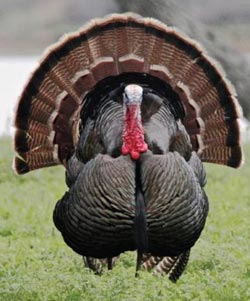Wild turkey damage to crops and wildlife mostly exaggerated

This image shows a male or tom wild turkey (M. gallopavo).<br><br>Credit: Entomological Society of America<br>
As populations of wild turkeys have increased, the number of complaints about crop damage has also increased. However, a literature review which will be published in the June 2013 issue of Journal of Integrated Pest Management, finds that these claims are mostly exaggerated.
The literature review, entitled “Real and Perceived Damage by Wild Turkeys: A Literature Review,” was conducted to determine real and perceived damage caused by wild turkeys in North America. The results show that although wild turkeys can cause damage to agricultural crops such as corn, soybeans, wheat, and hay, the majority of actual damage is usually minor or caused by other wildlifesuch as white-tailed deer or raccoons. Thus, estimates of damage by wild turkeys are often inflated.
The authors found that wild turkeys do occasionally damage specialty crops, turfgrass, or ornamental flowers that may have higher value than common agricultural crops, but because of the small size of many specialty operations, simple damage management techniques mcan be used to reduce damage.
The authors also investigated the effects wild turkeys may have on other species of wildlife, but found no evidence of widespread negative effects. While wild turkeys have been observed consuming unusual or uncommon food items including snakes, salamanders, lizards, bluegill, crayfish, and tadpoles, such events were rarely documented. Wild turkeys have also been implicated in the decline of bobwhite quail and ring-necked pheasants, but the authors were unable to find any scientific evidence to substantiate these claims.
To the contrary, some studies in the reviewed literature note that wild turkeys can benefit society, and landowners have indicated that wild turkeys benefit agricultural crops by eating insects and controlling weeds. In some cases, while wild turkeys may appear to be damaging crops, they are actually feeding on insects or waste grain.
The full study will be made available to the public upon publication in June. Journalists who would like an advanced copy should write to pubs@entsoc.org or call 301-731-4535, ext 3009.
The Journal of Integrated Pest Management is an open-access, peer-reviewed, extension journal covering the field of integrated pest management. The intended readership for the journal is any professional who is engaged in any aspect of integrated pest management, including, but not limited to, crop producers, individuals working in crop protection, retailers, manufacturers and suppliers of pest management products, educators, and pest control operators.
The Journal of Integrated Pest Management is published by the Entomological Society of America (ESA), the largest organization in the world serving the professional and scientific needs of entomologists and people in related disciplines. Founded in 1889, ESA today has more than 6,000 members affiliated with educational institutions, health agencies, private industry, and government. Members are students, researchers, teachers, extension service personnel, administrators, marketing representatives, research technicians, consultants, and hobbyists.
Media Contact
More Information:
http://www.entsoc.orgAll latest news from the category: Agricultural and Forestry Science
Newest articles

Trotting robots reveal emergence of animal gait transitions
A four-legged robot trained with machine learning by EPFL researchers has learned to avoid falls by spontaneously switching between walking, trotting, and pronking – a milestone for roboticists as well…

Innovation promises to prevent power pole-top fires
Engineers in Australia have found a new way to make power-pole insulators resistant to fire and electrical sparking, promising to prevent dangerous pole-top fires and reduce blackouts. Pole-top fires pose…

Possible alternative to antibiotics produced by bacteria
Antibacterial substance from staphylococci discovered with new mechanism of action against natural competitors. Many bacteria produce substances to gain an advantage over competitors in their highly competitive natural environment. Researchers…





















